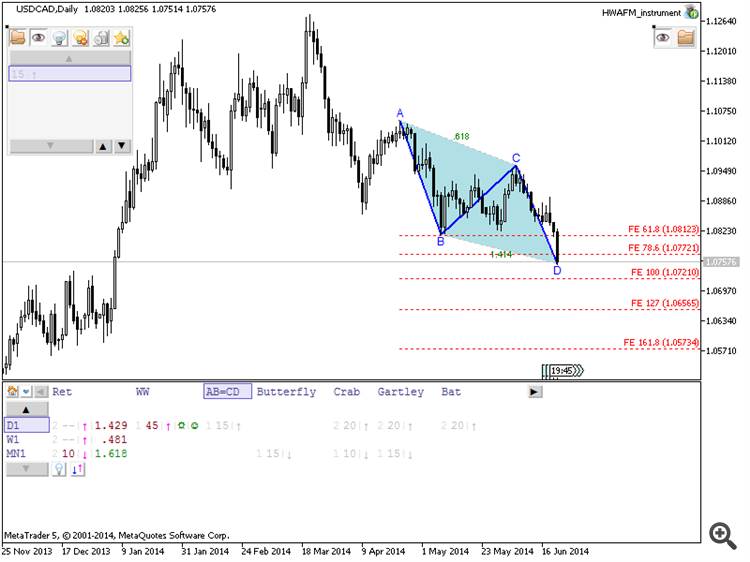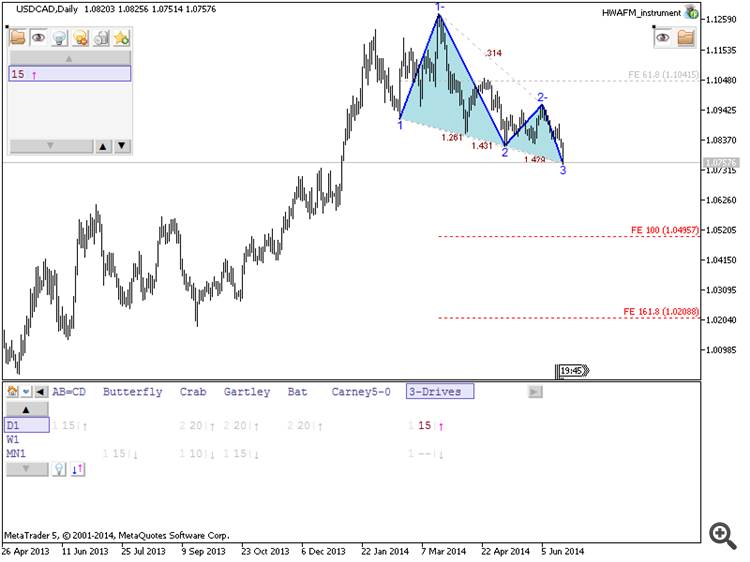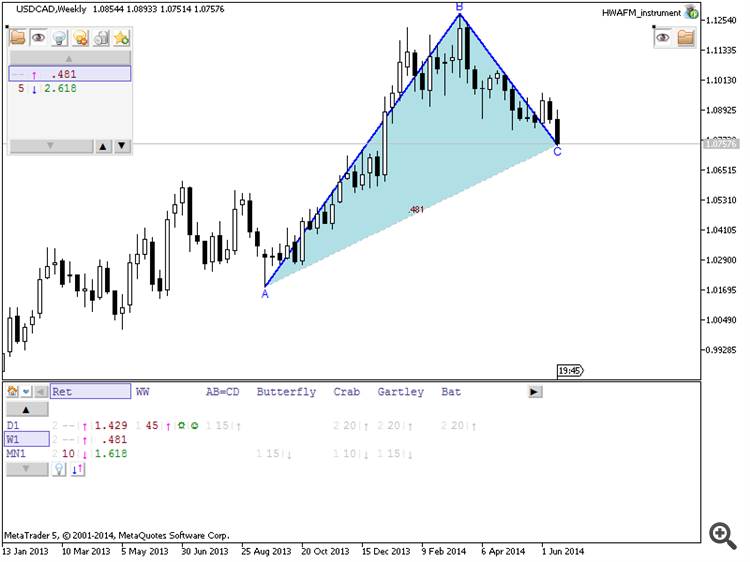You are missing trading opportunities:
- Free trading apps
- Over 8,000 signals for copying
- Economic news for exploring financial markets
Registration
Log in
You agree to website policy and terms of use
If you do not have an account, please register
Forum on trading, automated trading systems and testing trading strategies
Press review
newdigital, 2014.06.20 09:54
Trading the News: Canada Consumer Price Index (based on dailyfx article)
Despite expectations of seeing a 0.6% rebound in Canada Retail Sales, the Consumer Price Index (CPI) may play a greater role in driving the USD/CAD as the Bank of Canada (BoC) retains a rather dovish tone for monetary policy.

What’s Expected:
Why Is This Event Important:
A further pickup in core price growth may encourage the BoC to adopt a more hawkish tone for monetary policy, and we may see Governor Stephen Poloz continue to talk down bets for a rate cut should the data print curb the threat for disinflation.
The pickup in wage growth paired with the ongoing recovery in private sector activity may limit the downside risk for inflation, and a strong CPI print may generate fresh monthly lows in the USD/CAD as market participants scale back bets of seeing lower borrowing costs in Canada.
However, firms may offer discounted prices amid the slowdown in economic activity along with the downturn in private sector spending, and a weaker-than-expected inflation print may spur a near-term correction in the USD/CAD as it raises the risk for a rate cut.
How To Trade This Event Risk
Bullish CAD Trade: Core Inflation Rises 1.5% or Greater
- Need red, five-minute candle following the CPI report to consider short USD/CAD entry
- If the market reaction favors a bullish Canadian dollar trade, establish short with two position
- Set stop at the near-by swing high/reasonable distance from cost; use at least 1:1 risk-to-reward
- Move stop to entry on remaining position once initial target is hit, set reasonable limit
Bearish CAD Trade: Canada Price Growth Disappoints- Need green, five-minute candle following the release to look at a long USD/CAD trade
- Carry out the same setup as the bullish loonie trade, just in the opposite direction
Potential Price Targets For The ReleaseUSD/CAD Daily
- Fails to Retain Series of Higher-Highs/Lows; Bearish RSI Break Favors Downside Target
- Interim Resistance: 1.1000 (1.618% expansion) to 1.1020 (23.6% retracement)
- Interim Support: 1.0710 (100.0% expansion) to 1.07309
Impact that the Canada CPI report has had on CAD during the last month(1 Hour post event )
(End of Day post event)
2014
April 2014 Canada Consumer Price Index (CPI)
USDCAD M5 : 24 pips price movement by CAD - CPI news event:
The headline reading for Canada inflation climbed an annualized 2.0% in April to mark the fastest pace of growth since April 2012, while the core Consumer Price Index (CPI) advanced 1.4% after expanding 1.3% the month prior. The uptick in price growth propped up the Canadian dollar, with the USD/CAD slipping back below the 1.0900 handle, and the dollar-loonie continued to trade lower throughout the day as the pair closed at 1.0864.
USDCAD M5 : 55 pips price movement by CAD - CPI news event:
Forum on trading, automated trading systems and testing trading strategies
Press review
newdigital, 2014.06.20 18:23
EUR/USD at Trendline; USD/CAD Breaks Support (based on forexminute article)
A main theme in the forex market this week was the USD softening after the FOMC. Let’s see how that manifested in the EUR/USD. Today, Strong retail sales and hot inflation data from Canada is boosting the Loonie. Let’s take a look at the USD/CAD.
EUR/USD rallied this week after putting in a price bottom last week. There was broad USD-weakness after the FOMC event risk, and the EUR/USD popped up from the price bottom, only to stalled at 1.3643. As we get into the 6/20 session, we see that traders faded the pair down to a rising trendline. A break below 1.3550 should clear the trendline and the moving averages in the 4H chart. If the RSI also dips below 40, then we could be looking at a bearish continuation signal, refocusing traders on the 1.35 handle and the 1.3476 low on the year. Above 1.3560, the pair remains bullish in the very short-term, with upside toward 1.3676 June high.
USD/CAD is blasting through consolidation support today after very hot inflation and*retail sales data from Canada. The CPI in May came in at 0.5% on the month, and 2.3% on the year. This was a pick up from April’s reading and also beat most economists’*forecasts. Retail sales also grew 1.1% in April, faster than the 0.1% in March. Economists had forecast a 0.4% growth.
As both inflation and demand data moved higher and beat estimates, USD/CAD fell below its recent consolidation support at 1.0815. The dip is also breaking below the 200-day SMA. The 1.0737 pivot might provide some short-term support. But as long as price is below 1.09, there is downside risk toward the low on the year near 1.06, and the Dec. 2013 low at 1.0560.
USDCAD M5 : 55 pips price movement by CAD - CPI news event:
This is the final resulta for CAD - CPI news event: +60 pips by equity - see image
Forum on trading, automated trading systems and testing trading strategies
Press review
newdigital, 2014.06.21 19:16
Weekly Review and Outlook: Fed Sent Stocks to Records and Weighed Down Dollar, Canadian Dollar Shone
Fed Sent Stocks to Records and Weighed Down Dollar, Canadian Dollar ShoneDollar ended the week generally lower except versus the Japanese yen and Aussie even though Fed continued with tapering of the asset purchases. Markets seemed to have ignored the slight upward revision on FOMC member's rate forecasts, but were more focus on Yellen's message of keeping rates low for extended time. The sentiments also sent stocks higher with DOW and S&P 500 hitting new record highs while keeping long term treasury yields in range. In the currency markets, Canadian dollar was the strongest one as the upside surprise in inflation data prompted speculation that BoC would shift away from its neutral stance. The Swiss franc was the second strongest one after SNB kept policies unchanged. Sterling extended recent rally against dollar and Euro but ended the week mixed overall. Aussie was the weakest, just followed by yen.

To recap some of the major events, FOMC announced to continue tapering by lowering the monthly asset purchases from USD 45b by USD 10b to USD 35b. After the reduction, the monthly purchases consist of USD 20b of treasuries and USD 15b of MBS. Fed also released updated economic projection. 2014 growth forecast was slashed to 2.1% - 2.3%, substantially down from prior estimate of 2.8% - 3.0%. 2015 and 2016 growth forecast was left unchanged at 3.0% - 3.2% and 2.5% - 3.0% respectively. Unemployment projection was revised lower to 6.0% - 6.1, down from March projection of 6.1% - 6.3%. 2015 and 2016 unemployment forecast was also lowered. Core inflation is projection to be 1.5% - 1.6% in 2014, slightly up from March projection of 1.4% - 1.6%. 2015 and 2016 projections were also revised higher. On average, policy makers are seeing the Benchmark federal funds rate at 1.2% by end of 2015 and 2.5% by end of 2016. That's an upward revision from March projection of 1.125% in 2015 and 2.4% in 2015. The long term average, however, is now forecast to be at 3.75%, down from prior forecast of 4.0%.
The IMF lowered growth forecast of US this year sharply to 2.0%, down from April's projection of 2.8%. 2015 growth projection was left unchanged at 3.0%. The cut in forecast was mainly due to contraction in Q1 on harsh winter weather. IMF also noted that "relatively high unemployment and a lot of slack in the labor market" to persist", and consumer inflation will remain well below the 2% target into 2017. Regarding monetary policy, IMF said Fed's policy rates could " afford to stay at zero for longer than the mid-2015 date currently foreseen by markets". Earlier this month, the World Bank lowered US 2014 growth forecast to 2.1%, down from prior projection of 2.8%.

Talking about IMF, it urged ECB to consider buying assets including sovereign bonds on a large scale to counter the stubbornly low inflation. IMF chief Lagarde said that "inflation is worryingly low across the euro-area countries." She welcomed recent stimulus measures announced by ECB, but she emphasized that "we are not at the end of the road."In a report, IMF note that new asset purchases would "boost confidence, improve corporate and household balance sheets, and stimulate bank lending." German ZEW economic sentiment dropped to 29.8 in June versus expectation of a rise to 35.0. Current situation gauge improved more than expected to 67.7. Eurozone ZEW economic sentiment rose less than expected to 58.4 versus consensus of 59.6. ZEW President Clemens Fuest noted that "the German economy is currently in a very good shape but further increases are becoming more difficult." And, he also said that “we had a strong first quarter in 2014 due to favorable weather conditions but signs are that the second quarter will be weaker."
In UK, BoE minutes for June meeting revealed that policy makers voted unanimously to keep rates unchanged at 0.50% and maintain the asset purchase size at GBP 375b. The minutes noted that "all members agreed that, in the absence of other inflationary pressures, it would be necessary to see more evidence of slack being absorbed before an increase in Bank Rate would be warranted." And, it warned that "a premature rise "could be associated with considerable costs in terms of lost output." However, some analysts noted that underneath the voting, the minutes showed a gradual chance in the tone of the MPC. In particular, the minutes noted that "the relatively low probability attached to a Bank Rate increase this year implied by some financial market prices was somewhat surprising". All in all, the minutes didn't provide enough "hawkishness" for markets to push Sterling further higher. Recent strength of Sterling was also dampened by lower than expected inflation data. CPI slowed to 1.5% yoy in May, down from April's 1.8%, versus consensus of 1.7% yoy. Core CPI slowed to 1.6% yoy versus expectation of 1.7% yoy.
SNB left the target range for the three-month Libor unchanged at 0-0.25%. Also, the EUR/CHF floor is held at 1.2. SNB president Jordan emphasized that the central bank will closely monitor the "impact of the recent interest rate reductions in the euro area on Switzerland. And he noted "we've said repeatedly that we don't exclude any measure and that the introduction of negative rates is a possible option." SNB lowered inflation projection for the next two years. CPI is expected to be at 0.3% in 20156 and 0.9% in 2016. 2014 inflation forecast was raised slightly to 0.1%. Swiss State Secretariat for Economics (SECO) lowered growth forecast of the economy. 2014 growth is projected to be 2.0% in 2014 versus prior forecast of 2.2%. 2015 growth is projected to be 2.6%, downgrade from prior forecast of 2.7%. SECO noted that "the economic picture is still split, with a good domestic economic trend on the one hand and muted exports on the other."
Canadian CPI rose 0.5% mom 2.3% yoy in May versus expectation of 0.2% mom, 2.1%. Core CPI rose 0.5% mom, 1.7% yoy versus expectation of 0 0.2% mom, 1.5% yoy. The headline CPI is back above 2% level for two consecutive months. That's also the highest figure in 27 months. And core CPI is heading back to 2% target. BoC left rates unchanged earlier this month, noting that "the timing and direction of the next change to the policy rate will depend on how new information influences the balance of risks." The set of inflation data could probably trigger a move away from such neutral stance in the coming policy statements.
RBA minutes showed that interest rates will likely be on hold in the foreseeable future. It note that "given this outlook for the economy and the significant degree of monetary stimulus already in place to support economic activity, the board judged that the current accommodative stance of policy was likely to be appropriate for some time yet." The central bank said that pace of growth will likely be "a little below trend" for the rest of the year. There will be "substantial falls in mining investment, "below-average growth of public demand" and subdued non-mining investment. Regarding the exchange change, RBA reiterated that it remained high by historical standards.
Technical Highlights
As noted in our USD/CAD weekly report, the pair has just resumed the medium term corrective fall from 1.1278 and should now be heading to 50% retracement of 1.0181 to 1.1278 at 1.0730 and below. However, as such decline is viewed as a correction only, we'd start to look for bottoming signal below 1.0730, and above 1.0608 cluster support (61.8% retracement of 1.0181 to 1.1278 at 1.0600). But before that, in near term, USD/CAD's outlook will stay bearish as long as 1.0960 resistance holds.

USD/CAD Weekly OutlookUSD/CAD's decline from 1.1278 finally resumed last week and dived to as low as 1.0751. Initial bias remains on the downside and deeper fall should be seen to 50% retracement of 1.0181 to 1.1278 at 1.0730. Such decline is still being viewed as a correction. Thus, we'd start to look for reversal signal below 1.0730 and above 1.0608 key support. On the upside, break of 1.0813 resistance will turn bias neutral first. Break of 1.0960 is needed to confirm near term reversal. Otherwise, outlook will stay bearish.
In the bigger picture, there is no clear sign that the whole up trend from 0.9633 and 0.9406 is reversing. We'll stay medium term bullish as long as 1.0608 support holds (61.8% retracement of 1.0181 to 1.1278 at 1.0600). Rise from 0.9406 is viewed as the third leg of the pattern from 0.9056 (2007 low) and is still expected to extend to 61.8% retracement of 1.3063 to 0.9406 at 1.1666 in medium term after completing the correction from 1.1278.
In the longer term picture, current development suggests that price actions from 0.9056 (2007 low) are developing into a long term sideway pattern. We'd expect range trading to continue in long term before seeing any further development.